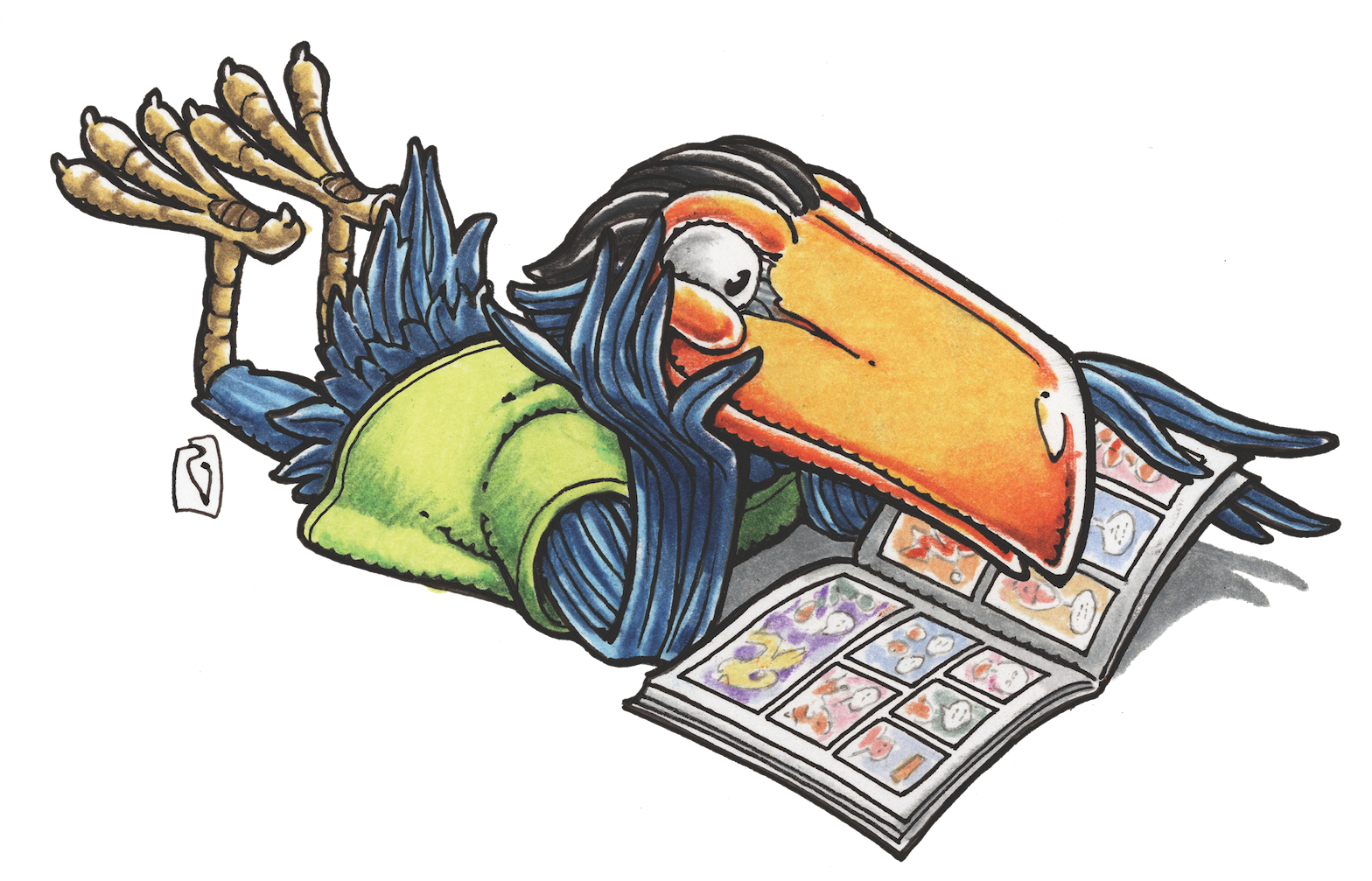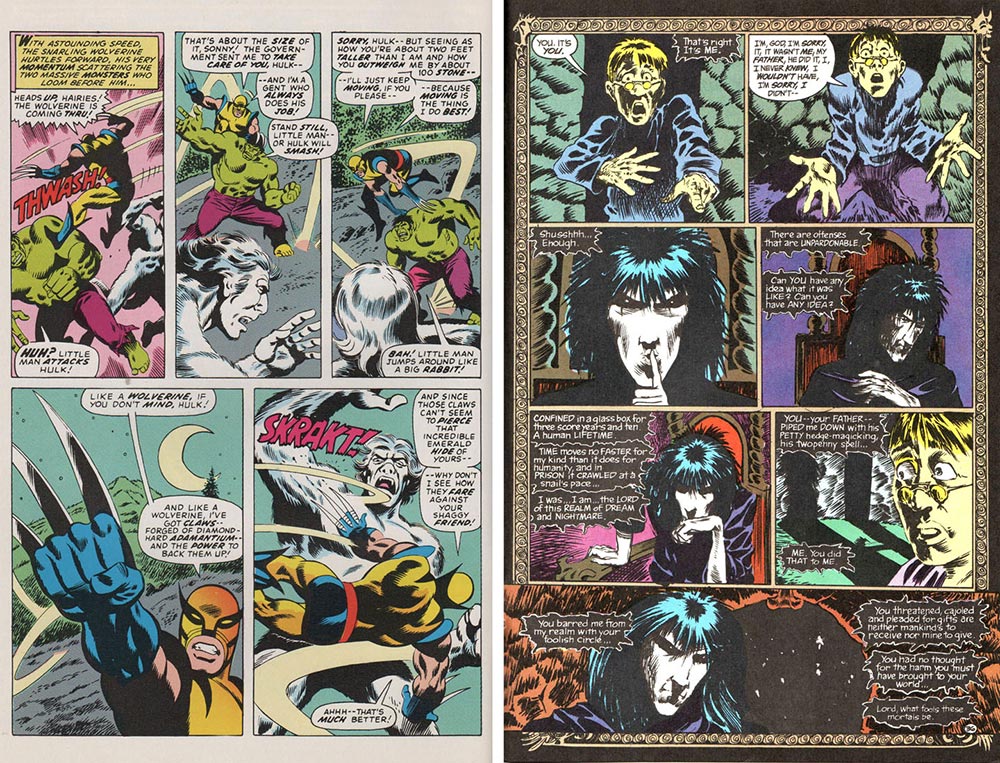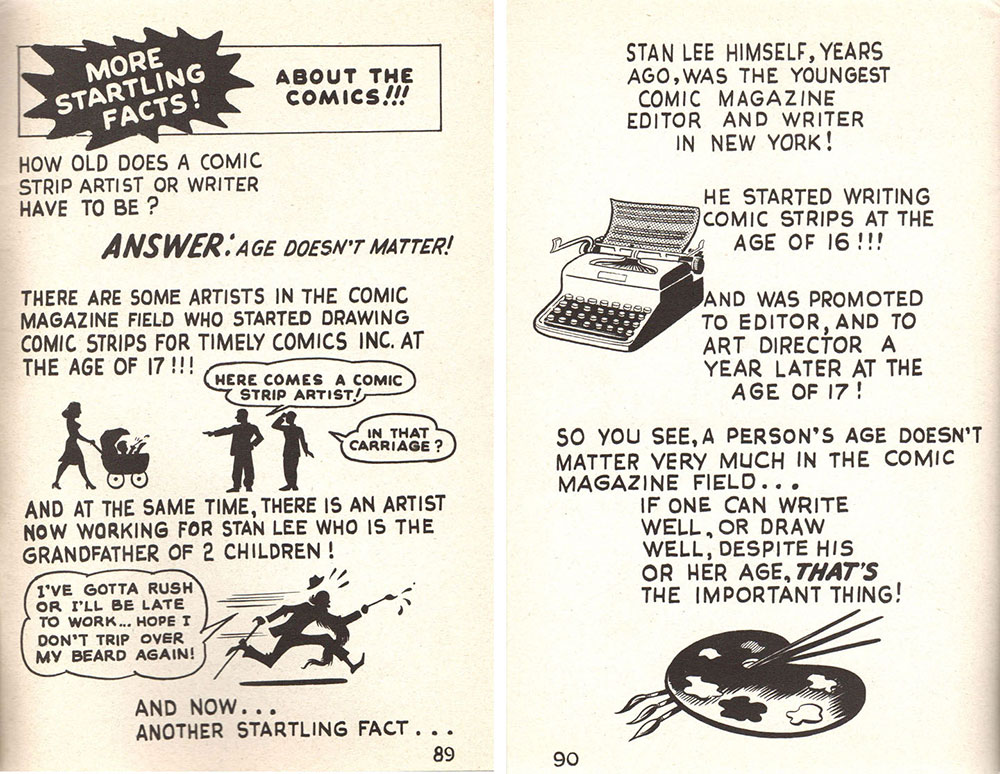MAGGIE’S WORLD BY MAGGIE THOMPSON
Maggie’s World 069: Age

At Comic-Con in 1992, Todd McFarlane received an Inkpot Award. He was 31 at the time (and had been experimenting with how to draw comics since he was a kid, having begun to develop Spawn when he was 16 years old). My husband, Don, noted in the presentation that Todd had begun to earn devoted fans while in his 20s. Don commented that many of the creators whom fans considered to be super-stars had also been young when they began their careers.
That night, Rick O’Shay creator Stan Lynde (who’d won an Inkpot 15 years earlier) thanked Don and noted that he, too, had been a young artist when he’d launched his own career.
When I recently looked through a copy of Stan Lee’s 1947 pamphlet Secrets Behind the Comics, I noticed that Stan had made a point of encouraging would-be young professionals to try their hand at the comic-book art form.
Numbers
So it was out of curiosity that I decided to check out more about creator ages. (It wasn’t for fun, because math and I are on only tentative terms. Hey, whereas Barbie first hit store shelves in March 1959, she was 33 when “Teen Talk Barbie” endorsed my experience, “Math class is tough.” And I didn’t do that math until just now.)
Evaluations are complicated by the fact that a lot of comics art is collaborative. For example, I began by considering inclusion of Archie in the research, but that quickly got nuts. Sure, artist Bob Montana was 20 when Pep #22 (December 1941) was published, but how old (and who, exactly) was writer Vic Bloom? Quickly, of course, I found myself in a deep dive into the involvement of John Goldwater. And Joe Edwards. And Harry Shorten. Heck, for that matter, should Archie’s evolution involve 1928’s and 1937’s Andy Hardy and 1938’s Henry Aldrich? Let’s just tiptoe away from such matters, while acknowledging that “creation” can itself be controversial, what with frequent involvement of a number of folks.

So it is that I’ve done little more than scratch the figurative surface of a topic that could eventually be the focus of some grad-student treatise. I’ve begun by picking a few creations at random in order to consider the age of their creators (dodging the detail of editorial contributions to the credited initial writer and penciller).
[To digress, in Dell Four Color #148 (Albert the Alligator and Pogo Possum, May 1947), Walt Kelly (writing at age 33) commented that a character was firing at random up the chimney. “Random is a thin man and hard to hit.” Indeed. So the random list picked for this project wouldn’t match the random choices of other comics buffs. Just note that fact.]
[Also: I focus on cover dates; old hands know that the issues were on newsstands a few weeks prior. If you didn’t know that already, just keep it in mind.]
Kids
Yep, Bob Montana was just out of his teens when he drew that first Archie story. In fact, an Excel-sort on a bunch of trail-blazing characters turn up several creators who were 23 when their characters’ first appearances hit newsstands.
For example, they’d been working on the character since they were teens, but Jerry Siegel and Joe Shuster were 23 by the time Superman made his debut in DC’s Action Comics #1—and artist Bob Kane was also 23, when Batman was introduced in Detective Comics #27, though writer Bill Finger was a couple years older.
For that matter, 23 seemed to be a terrific creative age for such other pros as Carl Burgos (Marvel’s Human Torch), Harry Lampert (DC’s Flash), Will Eisner (Register and Tribune Syndicate’s Spirit), Jack Kirby (Marvel’s Captain America), Jim Starlin (Marvel’s Thanos), Mike Friedrich (Thanos again!), and Rob Liefeld (Marvel’s Deadpool).

Maturity
Of course, some innovators had clearly trained for years before they introduced classic characters. Whether it was in military service, work in such studios as Walt Disney’s or Will Eisner’s, or freelancer activity, their eventual “overnight” success often followed long apprenticeships.
Charles Schulz was 27 when Peanuts first appeared in newspapers. Chic Young (Blondie), C.C. Beck (Captain Marvel), and Fabian Nicieza (Deadpool) were 29 when those characters were introduced. Chester Gould was 30 when Dick Tracy began tracking down villains; Marjorie Henderson Buell was 30 when Little Lulu began to bring wordless chaos to the lives of those about her.
Heck, Harley Quinn resulted from the collaboration of Bruce Timm (31 when her first adventure aired) and Paul Dini (35).

Time Spans
OK, thanks especially to “The Marvel Method” (in which the writer suggests a concept, the artist makes it clear, and the writer provides a follow-up script), Stan Lee went through a spectrum of development that included (but was clearly not limited to) Spider-Man and Fantastic Four at 38, Hulk at 39, X-Men at 40, and Black Panther at 43. And, yes, Jack Kirby’s work included (but was also clearly not limited to) Captain America at 23, Fantastic Four and Hulk at 44, X-Men at 46, and Black Panther at 48. (Heck, Kirby was hired away by DC at age 53, where he developed his “Fourth World” cosmos, and so on and definitely so forth.)
We used to run lists of birthdays in Comics Buyer’s Guide, and one well-known writer asked that we delete our listing of the year he was born, because he felt it would make editors less likely to give him work. So there’s that. Which is to say it’d be great to realize that “experienced” does not mean “over the hill.”
Too young? Too old? Heck, the age of pros when they create classics doesn’t matter—any more than do other aspects not clearly on exhibit in the story we hold in our hands.
So …
Ah, the heck with it. I began with curiosity backed by a couple of quickly constructed Excel files to see whether I could come up with some sort of wise generalization on “kids are best” or “experience is obvious.” Which I couldn’t.
And past and present mysteries remain, anyway. Even with Google at my beck and call, I can’t find much information on specific creative ages of Archie writer Vic Bloom, Patsy Walker writer Stuart Little [Hah! Yeah! Just try to find a non-mouse reference!], Sandman artist Mike Dringenberg, or Ms. Marvel artist Adrian Alphona. I guess we’ll just have to be satisfied by continuing to enjoy their stories. Which is to say, “Thanks!”
Maggie’s World by Maggie Thompson appears the first Monday of every month here on Toucan!